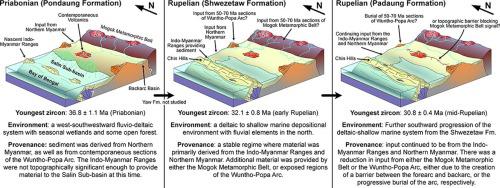Journal of Asian Earth Sciences ( IF 2.7 ) Pub Date : 2021-05-13 , DOI: 10.1016/j.jseaes.2021.104825 Joseph D. McNeil , Amy Gough , Robert Hall , Nils Keno Lünsdorf , Max Webb , Sarah Feil

|
The Salin Sub-basin, Myanmar, contains up to 15,000 m of Cenozoic sediments, but their provenance remains ambiguous. Here, a multi-proxy provenance study that employed Raman Spectroscopy-assisted heavy mineral analysis, light mineral petrography, and U-Pb detrital zircon geochronology, is used to identify source areas and sediment pathways of nine samples from three formations of Eocene to Oligocene age. The heavy mineral assemblages are diverse and highly immature and indicate that sediments were principally provided from a range of igneous and metamorphic lithologies, with some recycling of older sediments. The metamorphic basement rocks in northern Myanmar are identified as a source in all three formations, suggesting that the headwaters of the sedimentary pathway were situated in this area. Detrital zircons overwhelmingly yield Cretaceous and Palaeogene ages. A population of Late Cretaceous and Palaeocene zircons could indicate input from the Mogok Metamorphic Belt, or a currently buried section of the Wuntho-Popa Arc; the diminishing of this signal by the end of the Rupelian suggests reduction in transport from the former, or burial of the latter. Late Cretaceous grains exhibit rounded and euhedral morphologies, suggesting input from recycled Wuntho-Popa Arc material via the sediments of the Chin Hills, and direct input from the Wuntho-Popa Arc, respectively. A persistent Palaeoproterozoic and Triassic signal in the Shwezetaw and Padaung Formations suggests provenance in the Pane Chuang Formation of the Indo-Myanmar Ranges, showing that by the early-mid Oligocene, the ranges were topographically prominent enough to be an important source of sediment for the Central Myanmar Basin.
中文翻译:

缅甸萨林次盆地始新世至渐新世砂岩的多代烃源研究
缅甸萨林次流域包含多达15,000 m的新生代沉积物,但其出处仍不明确。在这里,一项利用拉曼光谱辅助的重矿物分析,轻矿物岩石学和U-Pb碎屑锆石年代学的多代理物来源研究被用来识别从始新世到渐新世的三个地层的九个样品的来源区域和沉积途径。 。重矿物组合是多种多样的,并且高度不成熟,表明沉积物主要是由一系列火成岩和变质岩性提供的,并且对较旧的沉积物进行了一定程度的再循环。缅甸北部的变质基底岩被确定为这三个地层的烃源,这表明沉积路径的源头就位于该区域。碎屑锆石绝大多数产生白垩纪和古近纪。晚白垩世和古新世锆石的种群可能表明来自Mogok变质带或Wuntho-Popa弧目前被掩埋的部分的输入。在Rupelian结束时该信号的减弱表明从前者的运输减少或后者的埋葬。晚白垩世颗粒呈现出圆形和本构面的形态,这表明来自回收的Wuntho-Popa弧物质通过下丘山沉积物的输入,以及来自Wuntho-Popa弧的直接输入。Shwezetaw和Padaung组中持续存在的古元古代和三叠纪信号表明,印度-缅甸山脉的Pane Chuang组有物源,表明在渐新世中期到中期,











































 京公网安备 11010802027423号
京公网安备 11010802027423号